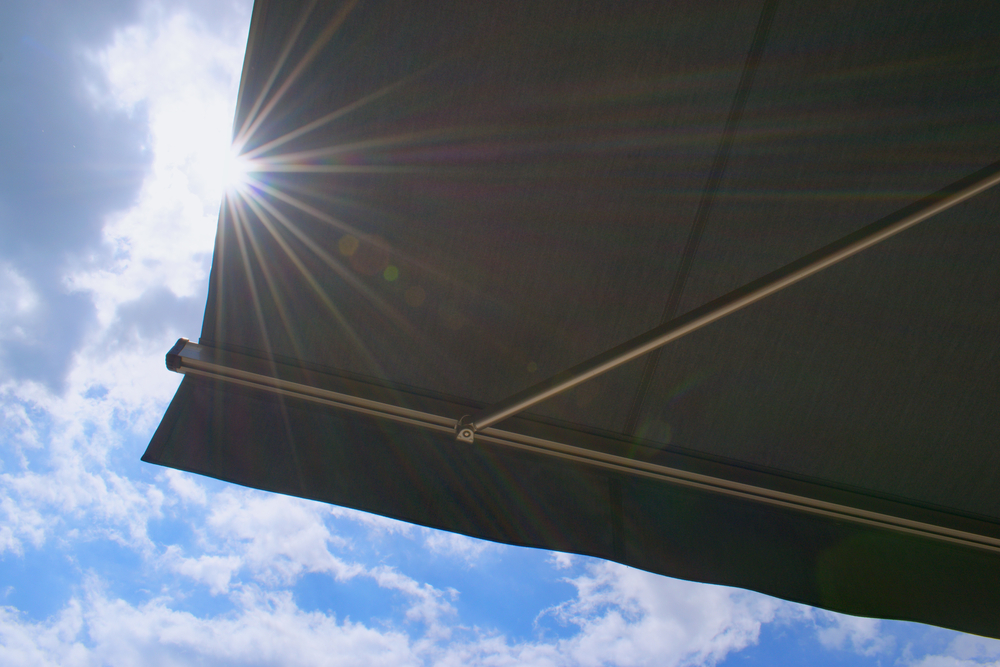Awning Fabric: How to Repair or Replace It

When you have a retractable awning as part of your home or business, you know just how great an investment it has been over the years. However, if it’s been 10-15 years since you first had your awning installed, it may be time to replace your awning fabric.
While this may sound complex and very expensive, it is actually much easier than you may think. If you’re ready to learn how to tell if you need to change your awning fabric, replace your entire awning altogether, and whether you should replace your awning’s fabric yourself or leave it to the pros, here’s all you need to know, courtesy of us here at Rollac.
Signs Your Awning Needs Fabric Repair
Visible Thinning
Even when you give regular maintenance to your awning, the fabric will eventually begin to succumb to the elements and the usual wear and tear that comes with aging. If your awning is subject to high wind gusts year after year, the metal structure may hold up well, but the constant stress of the wind on the fabric will eventually take its toll. When you begin to notice you can see through the awning fabric a bit too much, repairs may be needed.
Color Fading
Along with the wind, UV rays from the sun can be very hard on awning fabric. Over time, the fabric will begin to lose its once-vibrant color. When it gets to the point of being noticeable, you may want to consider awning fabric repair.
Small Rips and Punctures
If you have trees near your awning, even smaller limbs that you assume won’t cause any damage can fall and leave small tears or punctures in the fabric. Once these issues are noticed, you should take care of them right away. Otherwise, small holes will become big ones before too long.
Signs Your Awning Fabric Needs to be Replaced
Large Holes
Whether you have ignored what was once only a small hole in your awning or have a very large tree limb or other object fall onto the awning’s fabric, a large hole or multiple holes in your awning’s fabric likely means you will need to replace your entire awning. Since it is likely structural damage has also taken place with your awning, failing to replace it could put you and others at risk of being injured.
Mold and Mildew
Should you live in an area where heavy rain occurs on a regular basis, you may want to consider installing a waterproof retractable awning at your home or business. If you don’t, mold and mildew may become a problem that results in the need for a new awning. While you can clean your awning to prevent mold and mildew, letting too much of it build up over time may prove to be too much.
Sagging
When you have a retractable awning and want to keep it in good condition, don’t let vegetation or debris accumulate on it. When this is allowed to happen, the fabric can start sagging. If it stretches too much, it will be beyond repair.
Rust
When you are looking at your drop arm awning and notice rust on its metal parts, don’t let that rust linger any longer than necessary. Once rust forms on metal, it greatly accelerates the metal’s aging process. This could mean part of the metal structure could snap when you least expect it, leaving you and anyone else nearby surprised and injured.
Can You Replace Awning Fabric Yourself?
Yes, you can replace awning fabric yourself as a DIY project. To do so, here are the various steps you’ll need to follow.
- Remove the Old Fabric
To do this, remove the screws from the awning bar, then remove the end cap. Loosen the bar, slide out the valance, then take out the fabric roller and fabric.
- Measure the Old Fabric
If you don’t measure the old fabric once it’s removed, you won’t know the correct size of new fabric you will need. Measure the fabric’s length and width twice, just to make sure your measurements are accurate.
- Choose Replacement Fabric
Next, choose your replacement fabric. Remember, you will probably have to cut it some to get an exact fit on your awning. Note the specific shape of your awning, then use specialized fabric-cutting scissors to get a clean cut.
- Install the New Fabric
To install the new fabric, first place it on the fabric roller and tighten all necessary screws. Then replace the end cap, making sure it too is screwed into place. Finally, put the awning bar back in place, making sure it is secured and that the fabric looks and lines up as you expected.
DIY vs. Hiring an Awning Pro
While it is not hard to replace awning fabric, it is also a project where you could potentially make plenty of mistakes along the way. For example, if you measure incorrectly and then start cutting on your new awning fabric, you may ruin it and find yourself spending money yet again for more fabric.
Also, if you find it hard to stand on a ladder to perform certain tasks, you may not want to try replacing your awning fabric on your own. If all goes well with your DIY project, you can save substantially on labor costs. However, should you have any concerns about your ability to complete the job successfully, we suggest you hire an awning pro to ensure you get great results.
Know When to Call the Pros
Since you have made quite an investment in your retractable awning and want it to look fantastic and perform perfectly for many years, know when to call the pros for either awning fabric replacement or if you need a new awning installed at your home or business. To make sure the job is done right the first time, contact us here at Rollac. By placing your trust in us, you’ll have professionals on the job who are committed to excellence.
